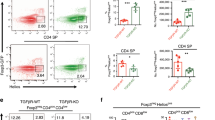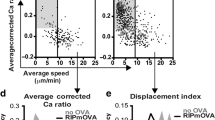Abstract
The autoimmune regulator Aire is a key mediator of central tolerance for peripherally restricted antigens. Its absence in human patients results in autoimmune polyendocrinopathy–candidiasis–ectodermal dystrophy. The cellular signals that regulate Aire expression are undefined. We show here that lymphotoxin signaling is necessary for the expression of Aire and its downstream target genes. The failure of Aire induction in the thymi of lymphotoxin-deficient and lymphotoxin-β receptor–deficient mice contributes to overt autoimmunity against self antigens normally protected by Aire. Conversely, stimulation of lymphotoxin-β receptor by agonistic antibody leads to increased expression of Aire and tissue-restricted antigens in both intact thymi and cultured thymic epithelial cell line. These findings define the essential cross-talk between thymocytes and thymic stroma that is required for central tolerance.
This is a preview of subscription content, access via your institution
Access options
Subscribe to this journal
Receive 12 print issues and online access
$209.00 per year
only $17.42 per issue
Buy this article
- Purchase on Springer Link
- Instant access to full article PDF
Prices may be subject to local taxes which are calculated during checkout





Similar content being viewed by others
References
Derbinski, J., Schulte, A., Kyewski, B. & Klein, L. Promiscuous gene expression in medullary thymic epithelial cells mirrors the peripheral self. Nat. Immunol. 2, 1032–1039 (2001).
An autoimmune disease, APECED, caused by mutations in a novel gene featuring two PHD-type zinc-finger domains. The Finnish-German APECED Consortium. Autoimmune polyendocrinopathy-candidiasis-ectodermal dystrophy. Nat. Genet. 17, 399–403 (1997).
Ahonen, P. Autoimmune polyendocrinopathy–candidosis–ectodermal dystrophy (APECED): autosomal recessive inheritance. Clin. Genet. 27, 535–542 (1985).
Bjorses, P., Aaltonen, J., Horelli-Kuitunen, N., Yaspo, M.L. & Peltonen, L. Gene defect behind APECED: a new clue to autoimmunity. Hum. Mol. Genet. 7, 1547–1553 (1998).
Peterson, P. et al. APECED: a monogenic autoimmune disease providing new clues to self-tolerance. Immunol. Today 19, 384–386 (1998).
Anderson, M.S. et al. Projection of an immunological self shadow within the thymus by the aire protein. Science 298, 1395–1401 (2002).
Fu, Y.X. & Chaplin, D.D. Development and maturation of secondary lymphoid tissues. Annu. Rev. Immunol. 17, 399–433 (1999).
Ware, C.F., VanArsdale, T.L., Crowe, P.D. & Browning, J.L. The ligands and receptors of the lymphotoxin system. Curr. Top. Microbiol. Immunol. 198, 175–218 (1995).
Cyster, J.G. Chemokines and cell migration in secondary lymphoid organs. Science 286, 2098–2102 (1999).
Wu, Q. et al. Reversal of spontaneous autoimmune insulitis in nonobese diabetic mice by soluble lymphotoxin receptor. J. Exp. Med. 193, 1327–1332 (2001).
Agyekum, S. et al. Expression of lymphotoxin-β (LT-β) in chronic inflammatory conditions. J. Pathol. 199, 115–121 (2003).
Mackay, F. et al. Both the lymphotoxin and tumor necrosis factor pathways are involved in experimental murine models of colitis. Gastroenterology 115, 1464–1475 (1998).
Banks, T.A. et al. Lymphotoxin-α-deficient mice. Effects on secondary lymphoid organ development and humoral immune responsiveness. J. Immunol. 155, 1685–1693 (1995).
Futterer, A., Mink, K., Luz, A., Kosco-Vilbois, M.H. & Pfeffer, K. The lymphotoxin-β receptor controls organogenesis and affinity maturation in peripheral lymphoid tissues. Immunity 9, 59–70 (1998).
Browning, J.L. & French, L.E. Visualization of lymphotoxin-β and lymphotoxin-β receptor expression in mouse embryos. J. Immunol. 168, 5079–5087 (2002).
Heino, M. et al. RNA and protein expression of the murine autoimmune regulator gene (Aire) in normal, RelB-deficient and in NOD mouse. Eur. J. Immunol. 30, 1884–1893 (2000).
Burkly, L. et al. Expression of relB is required for the development of thymic medulla and dendritic cells. Nature 373, 531–536 (1995).
Dejardin, E. et al. The lymphotoxin-β receptor induces different patterns of gene expression via two NF-κB pathways. Immunity 17, 525–535 (2002).
Klug, D.B., Carter, C., Gimenez-Conti, I.B. & Richie, E.R. Cutting edge: thymocyte-independent and thymocyte-dependent phases of epithelial patterning in the fetal thymus. J. Immunol. 169, 2842–2845 (2002).
Faas, S.J., Rothstein, J.L., Kreider, B.L., Rovera, G. & Knowles, B.B. Phenotypically diverse mouse thymic stromal cell lines which induce proliferation and differentiation of hematopoietic cells. Eur. J. Immunol. 23, 1201–1214 (1993).
Vukmanovic, S., Jameson, S.C. & Bevan, M.J. A thymic epithelial cell line induces both positive and negative selection in the thymus. Int. Immunol. 6, 239–246 (1994).
Murumagi, A., Vahamurto, P. & Peterson, P. Characterization of regulatory elements and methylation pattern of the autoimmune regulator (AIRE) promoter. J. Biol. Chem. 278, 19784–19790 (2003).
Ettinger, R. et al. A critical role for lymphotoxin-β receptor in the development of diabetes in nonobese diabetic mice. J. Exp. Med. 193, 1333–1340 (2001).
Liston, A., Lesage, S., Wilson, J., Peltonen, L. & Goodnow, C.C. Aire regulates negative selection of organ-specific T cells. Nat. Immunol. 4, 350–354 (2003).
Zuklys, S. et al. Normal thymic architecture and negative selection are associated with Aire expression, the gene defective in the autoimmune-polyendocrinopathy-candidiasis-ectodermal dystrophy (APECED). J. Immunol. 165, 1976–1983 (2000).
Yilmaz, Z.B., Weih, D.S., Sivakumar, V. & Weih, F. RelB is required for Peyer's patch development: differential regulation of p52-RelB by lymphotoxin and TNF. Embo. J. 22, 121–130 (2003).
Pomerantz, J.L. & Baltimore, D. Two pathways to NF-κB. Mol. Cell. 10, 693–695 (2002).
Grech, A.P. et al. Increased thymic B cells but maintenance of thymic structure, T cell differentiation and negative selection in lymphotoxin-α and TNF gene-targeted mice. Dev. Immunol. 8, 61–74 (2000).
Weih, F. et al. Both multiorgan inflammation and myeloid hyperplasia in RelB-deficient mice are T cell dependent. J. Immunol. 157, 3974–3979 (1996).
Browning, J.L. et al. Characterization of lymphotoxin-αβ complexes on the surface of mouse lymphocytes. J. Immunol. 159, 3288–3298 (1997).
De Togni, P. et al. Abnormal development of peripheral lymphoid organs in mice deficient in lymphotoxin. Science 264, 703–707 (1994).
Acknowledgements
Supported in part by National Institutes of Health grants (HD-37104, AI 33068 and DK-58891). R.K.C. and J.C.L. were supported by a Medical Scientist National Research Service Award (5 T32 GM07281).
Author information
Authors and Affiliations
Corresponding author
Ethics declarations
Competing interests
The authors declare no competing financial interests.
Rights and permissions
About this article
Cite this article
Chin, R., Lo, J., Kim, O. et al. Lymphotoxin pathway directs thymic Aire expression. Nat Immunol 4, 1121–1127 (2003). https://doi.org/10.1038/ni982
Received:
Accepted:
Published:
Issue Date:
DOI: https://doi.org/10.1038/ni982
This article is cited by
-
miR-155 exerts posttranscriptional control of autoimmune regulator (Aire) and tissue-restricted antigen genes in medullary thymic epithelial cells
BMC Genomics (2022)
-
Lymphotoxin: from the physiology to the regeneration of the thymic function
Cell Death & Differentiation (2021)
-
Transcriptional programs that control expression of the autoimmune regulator gene Aire
Nature Immunology (2017)
-
Epithelial LTβR signaling controls the population size of the progenitors of medullary thymic epithelial cells in neonatal mice
Scientific Reports (2017)
-
microRNA-449a modulates medullary thymic epithelial cell differentiation
Scientific Reports (2017)



